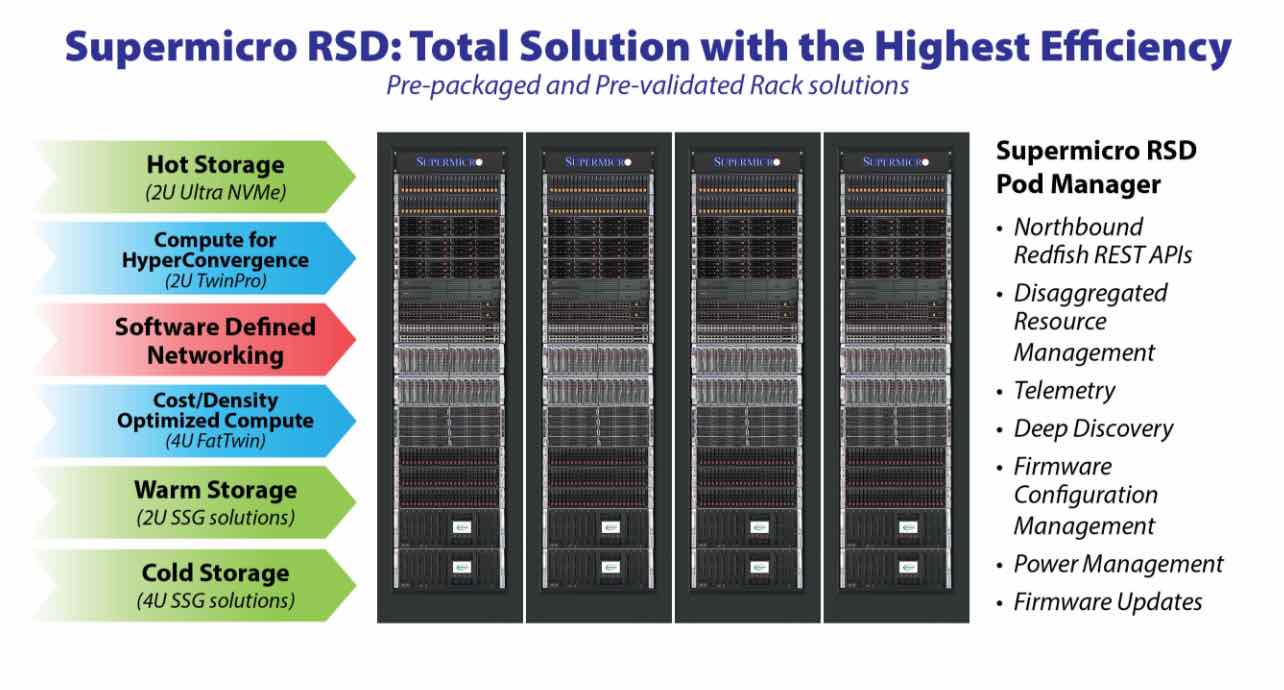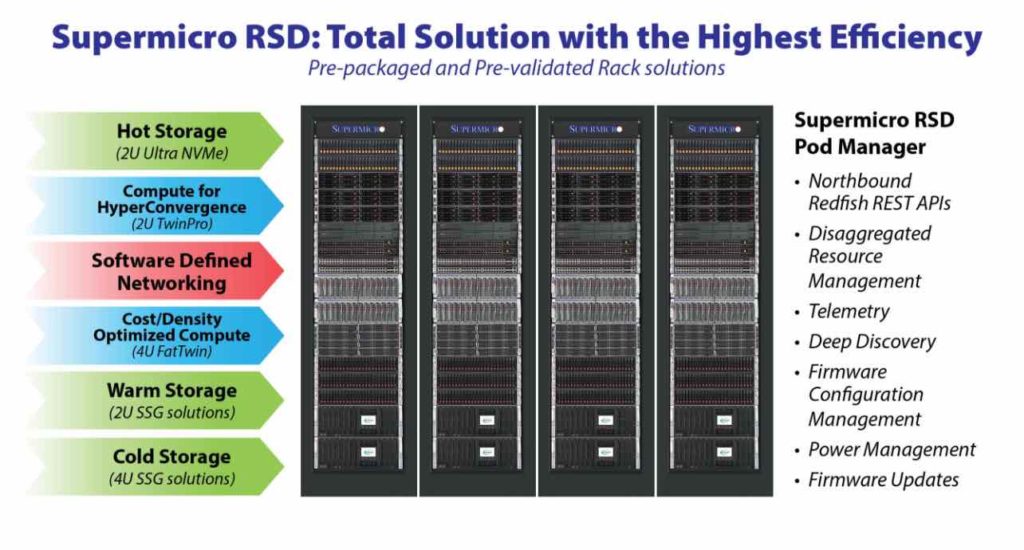Today Supermicro announced a new Rack Scale Design (RSD) solution that empowers cloud service providers, telecoms, and Fortune 500 companies to build their own agile, efficient, software-defined data centers. Supermicro RSD is a total solution comprised of Supermicro server/storage/networking hardware and an optimized rack level management software that represents a superset of the open source RSD software framework from Intel and industry standard Redfish RESTful APIs developed by DMTF (Distributed Management Task Force).
Supermicro RSD makes it easy for companies of any size to build cloud infrastructure that until now are limited to leading large public and private cloud providers,” said Charles Liang, President and CEO of Supermicro. “The Supermicro RSD solution enables more customers to build large scale modern data centers leveraging Supermicro’s best-of-breed server, storage and networking product portfolio.”
Supermicro RSD solves the hardware management and resource utilization challenges of data centers, large or small, often with tens of thousands of servers distributed in hundreds of racks using traditional 1-to-1 server management tool IPMI (Intelligent Platform Management Interface). Designed with the whole rack as the new management unit in mind, Supermicro RSD leverages open Redfish APIs to support composable infrastructure and enable interoperability among potential RSD offerings from different vendors. With industry standard Redfish APIs, Supermicro RSD can be further integrated into data center automation software such as Ansible, Puppet or private cloud software such as OpenStack or VMware.
Supermicro RSD rack level management software is based on the Intel® RSD framework, which provides the scale and efficiency for cloud operators to perform operations such as pooling and composability, in addition to the necessary telemetry and maintenance functions of the pod (a collection of racks) to manage allocated resources in a large scale data center environment. Users can provision, manage and power-on the composed node as if it were one physical node. When the task is complete, the user simply deletes the composed node to return the resource to the pools for other workloads.
A unique advantage Supermicro RSD solution offers is that it does not require purpose-built new hardware. In fact, the Supermicro RSD solution runs on all existing X10 (Broadwell) generation as well as new X11 generation server, storage and networking hardware. Furthermore, Supermicro MicroBlade offers a future-proof, disaggregated hardware that allows customers to independently refresh compute module (CPU + memory) hardware while keeping the remaining server investment intact resulting in substantial savings and flexibility.
The launch of Supermicro’s platform, incorporating Intel® Rack Scale Design, brings open, industry standards-based, hyperscale-inspired capabilities such as resource discovery, composability and telemetry to cloud, communications and enterprise data centers,” said Charlie Wuischpard, General Manager of Intel’s Scalable Data Center Solutions Group. “Supermicro’s solution, based on Intel RSD enables flexible, economical solutions for data centers, supported by Intel architecture and technologies.”
Supermicro RSD software includes the following components:
- Pod Manager (PodM):A pod is a collection of physical racks. Pod Manager sits at the top of the logical software hierarchy and uses Redfish API to communicate with the racks that make up the pod. It manages and aggregates the hardware resources within multiple racks in the Pod by polling respective PSMEs and RMMs
- Rack Management Module (RMM):RMM manages power and thermal resources within a rack by polling rack hardware and reports this information to PodM through Redfish API
Pooled System Management Engine (PSME): PSME acts as the drawer or chassis manager. PSME communicates with each BMC controller in the drawer/chassis and reports aggregated information such as telemetry and asset information through Redfish API to PodM - Web UI is a browser based graphical user interface that simplifies the management of RSD
- A minimum Supermicro RSD hardware configuration includes the following components:
- A 1U management appliance that bundles all RSD related software or a software only distribution
- Two Supermicro 1G management switches for connecting the baseboard management controllers (BMC)
- One Supermicro data switch
- Supermicro’s broad X10 and X11 server portfolio. Popular server choices include but are not limited to TwinPro, BigTwin, FatTwin, MicroBlade, SuperBlade and GPU servers
Popular Storage Choices include:
- 2U Ultra with 24 NVMe drives as hot storage,
- 2U SSG with 24 SAS drives as warm storage
- 45Bay, 60 bay or 90 bay JBODs as cold storage.




